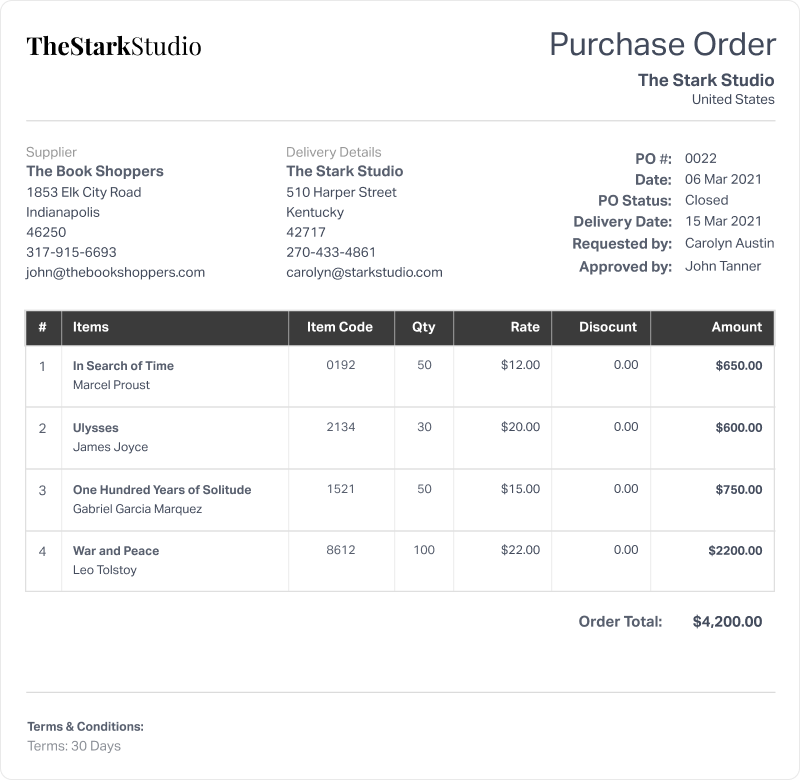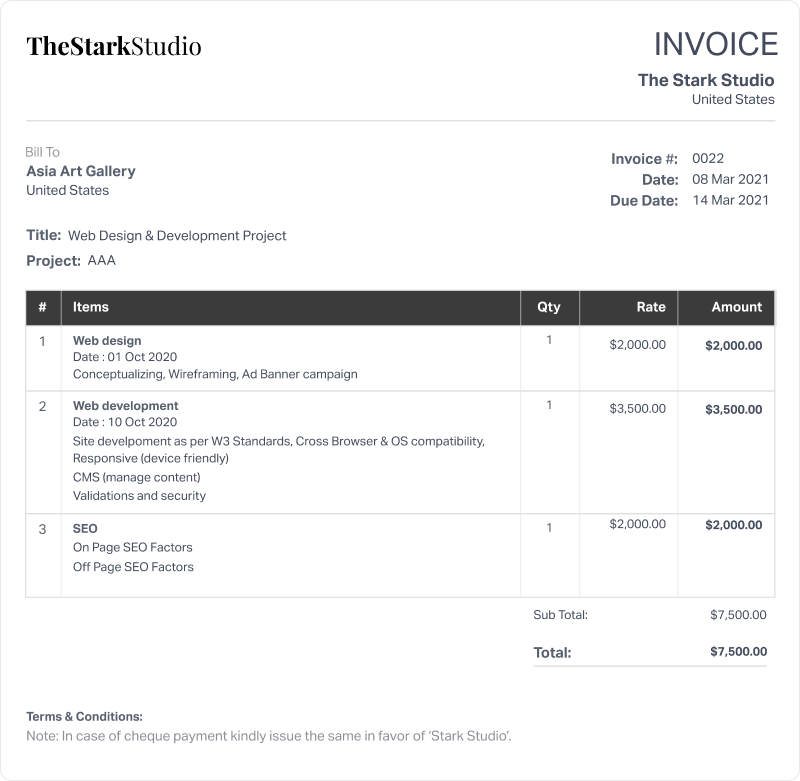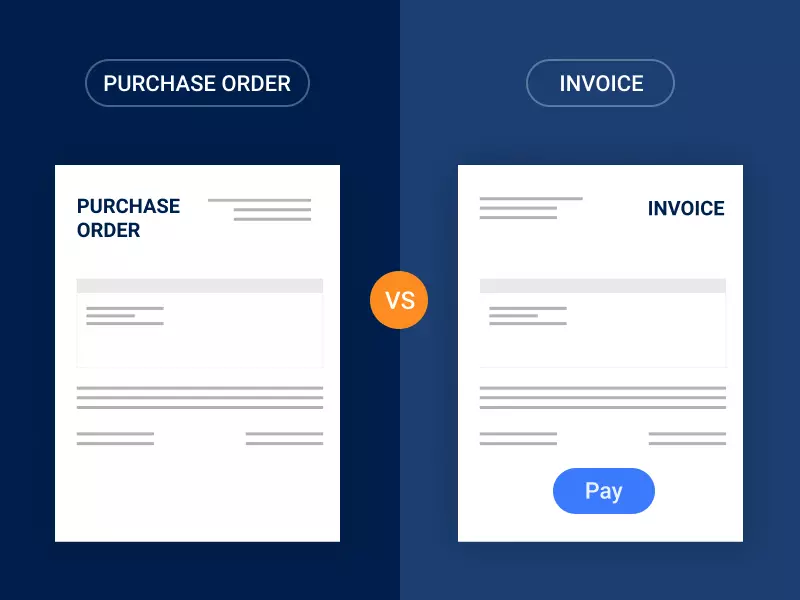Do you think business is all about paying and getting paid? Well, there is more to it! A business transaction is never complete without documenting a purchase for both the buyer and the seller. Whether you are new into this business arena or a professional one, you may often come across terms like purchase orders and invoices.
The procurement process includes various terms whether at a small business level or organizational level. Neglecting any one of those vital financial documents may impact your business expenses negatively. The account payable process depends on these financial documents.
Finding it difficult to figure out the differences between purchase order and invoice? We did the research for you! Go through this article to get all your doubts cleared.
Purchase order vs invoice
Do you find it difficult to figure out the differences between a purchase order and an invoice? The key difference is that the former one confirms the order placed and the later one requests payment after fulfilling the order.
To get a better idea of this, let’s clear the basics!
What is the Purchase Order?
A purchase order is a financial document that a buyer sends to the seller after placing an order for a required list of products or services. It includes the quantity (for products), prices, and delivery date. Moreover, this financial document also includes certain additional information regarding the preferred mode of payment, shipping details, and others. Once it is accepted by the seller, it becomes a legally binding contract.
You may come across terms like standing PO and Blanket PO. The former one facilitates recurring purchases, by placing the same order within a certain time frame under the same PO number. Whereas, the latter facilitates multiple deliveries for a particular set price that includes discounts and other incentives. This is mostly used for B2B purchases.
Relax! No more brainstorming as to what to add to this legally binding purchase document. Check out the section below to know more about this.
What do you get in a Purchase Order?
A purchase order outlines the following documents information:
- Product or Service Name
- Quantity
- Price
- Tax information
- Terms and conditions
- PO Number (Purchase Order Number)
- Payment Deadline
- ETA of the product delivery
- Name of requester and approver with details
You may often come across the word ‘purchase requisition’ as well. Is this the same as a purchase order? Well, no! A purchase order is processed externally and a purchase requisition is processed internally. A purchase requisition is sent by an employee of a company to the purchasing department (of the same company). The purchasing department gets the materials purchased from the outside vendor or merchant to complete the procurement process.
It might seem a lot, but this isn’t much. All the above information accounts for the validation of a business transaction. Moreover, these details keep track of future authentication during financial auditing in a company.
Purchase Order example

Purchase order comes with a unique identification number, which is definitely of great help. So let’s learn about this magic number!
Purchase Order Number
Among all the above terms purchase order number is something that may have tapped your mind at least once. Well, don’t just confuse it with a serial number. This is a unique reference number that differentiates every purchase order from all others. One can find this big and clear over the purchase order form that helps in generating an invoice. No matter whether a purchase order is generated through an automated or manual process, this number works out well for either of the cases for both the clients and the seller.
This number is great for future reference when you need to get on to a specific transaction. And maybe this is why companies prefer using a purchase order. Wondering why?- take a look!
Why do companies use a purchase order?
Whether a large company or a small business, purchase plans are common for all. If you have requirements for certain office supply needs, then you will need a purchase order to provide the product details to your vendor.
But the question lies in, who creates a purchase order?
For a well-built-up organization, there is a separate purchase department that is liable to maintain all the records and they are the ones who create a purchase order. But in the case of small or medium-sized organizations or maybe entrepreneurs, the requester creates their purchase orders on spot.
Both large organizations or small businesses require purchase orders for several reasons. Take a look:
- PO sets a clear expectation for both parties. It can be used for verifying the products in case deliverables do not match with the product list that was ordered.
- It helps you to get rid of duplicate requests. When the order requests increase it might create confusion. It monitors and tracks the order placed, so that unnecessary expenses can be prevented.
- You can control your business expenses by managing orders with the help of a purchase order. This helps to channelize the procurement process, maintain official documentation, and track and manages the orders for a more organized workflow.
- You can plan your future purchases and business expenses with the help of purchase orders. This helps you to arrange your budget more wisely.
- Purchase orders serve as legally binding documents. These also play a key role in business auditing. Auditors can detect financial discrepancies by analyzing your POs. This way you can save your business from any unwanted legal implications.
- You can manage your inventory with the help of a PO. Implement software to track your POs to determine your stock and streamline the inventory management system.
- Lastly, this is great for preventing cost overruns by detecting price hikes for a particular supplier.
Next, let’s run a check through the details related to an invoice. Get your invoicing basics cleared in the following sections!
What is an Invoice?
An invoice is a document that is created and documented by the seller after supplying the goods or services to track the payment. Invoices can be sent after the delivery of the goods or they can be sent along with the supplies that have been ordered by the customer.
A seller tracks the selling details through a sales invoice. This highlights the details that a customer owes for a specific purchase. The invoice also legally binds the requester, the way a purchase order does to the vendor.
Moreover, invoices are a key component in audit trails and bring forth essential information regarding specific transactions. With the implementation of software applications, one can generate electronic invoices easily. Invoices can be sent to their clients via email, which makes the payment procedure much faster.
What is included in an Invoice?
Just like purchase order, an invoice holds various key details that authenticate a business transaction. The information available on this are:
- Date of invoice creation
- Invoice number
- Contact details of buyer and seller ( Business name, address, and actual name)
- Product or Service description with unit price
- Estimated time of payment
- Payments adjustments
- Payment modes
- Taxes and discounts (if applicable)
- Total amount payable
- Invoice due date
The invoice structure varies depending upon the business needs and clientele demands.
Invoice example

Whether corporate clients or regular stores, an invoice is an essential document for all types of business establishments. But why do companies prefer this so much? Here’s your answer!
Why do companies use invoices?
The invoices are used by the companies or business owners for varied reasons.
- Invoice allows small business owners to receive their payment. The business has one way of functioning and it is important to maintain professionalism. Just a phone call or email does not help you to get your payment. For that, you need to issue an invoice with proper details to your clients.
- Invoices help you to keep a track of the services that you offer your clients. It also helps the clients to understand what they are paying for. Therefore, invoices offer visibility to business expenses from the clients’ ends and help track cash flow from the vendor’s end.
- Invoices are a great financial tool that helps you to manage your payments. If you are paying against an invoice then you can easily maintain every record of the payment, like the payment amount, date of payment, etc.
- An invoice is much similar to a purchase order in terms of legal binding. It has a vital significance in business audits.
- Invoices simplify processing your taxes. This helps you while auditing and reconciling when required.
- Lastly, invoices reflect your brand identity. Invoices help prove your credibility and professionalism.
Finally, to resolve all your confusions regarding the distinction between a purchase order and an invoice we have provided a detailed explanation of this. Take a look!
Differences between Purchase Order and Invoices
Once you step into the procurement arena you would often come across these financial tools. The easiest way to differentiate the functionalities of these documents is to understand the intention with which each of these are generated.
A purchase order initiates a business transaction that contains the client’s expectations regarding a specific product or service in terms of cost and delivery. Whereas, an invoice is a validating document that ensures that the product delivery is done.
An invoice order may contain the purchase order number for reference that validates that a certain order has been placed. Whereas, the purchase order does not have an invoice number.
For a better understating check out the below table to know the difference between purchase order vs invoice:
| Key Features | Purchase Order | Invoice |
| What is it? | Confirmation of an order placed for specific products/services | Payment request of an order |
| Issued by | Purchaser | Vendor |
| Received by | Vendor | Purchaser |
| When is it initiated? | At the onset of an order for products or/and services. | After delivery of the goods or services that are ordered. |
| How are these documents used to purchase services? | Even if the business transaction does not involve, one can definitely use a PO for services like painting a house. This will help to communicate to the clients about the cost related to the entire task. | Similarly, an invoice can also be issued after completing the painting job. One can add the services provided with respective costs and sent them to their clients requesting payments. |
| What is the information available? | 1. Date of PO issued 2. PO number 3. Purchaser name 4. Description of goods/services 5. Quantity of products 6. Billing and shipping address 7. Payment date 8. Payment terms | Besides the information available in a PO, an invoice has the following data: 1. Invoice issue date 2. Invoice date 3. Vendor contact information 4. Payment deadline 5. A Late fee or early discounts 6. Total amount due |
Despite the fact that both the business documents are quite different from each other, they possess certain similarities as well. Check it out!
Similarities between Purchase Order and Invoices
Though they sound different, they hold a lot of similarities.
Both the purchase order and an invoice legally binds the seller and clientele. Both of them agree on the same terms and conditions to process a business transaction further. Hence, it avoids confusion and protects either side from financial risk.
Next, comes the unique number which is common for both the PO and invoice. These numbers help a lot to track down a specific transaction for future reference.
Moreover, both these documents contain key details about the requester and approver that maintain parity and offer a hassle-free business deal with mutual benefits.
Bottom line!
Going digital makes your task a lot easier. Billbooks help generates purchase orders and invoices without any hassle. Get your documents ready in a minute and send them immediately without any delay.
Streamline the entire process with our software and manage your financial documents seamlessly. Start your free trial now!

To ensure a professional mode of transaction and timely payment both purchase order and invoice are essential. Whether you purchase or deliver, these are significant business tools that help in validating the payment system for both buyer and seller.



